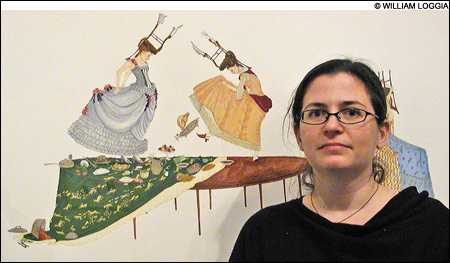The women in Amy Cutler’s drawings and paintings are odd and vulnerable but sometimes a formidable lot. A comprehensive collection from her fantastical world are on view in Amy Cutler, at Brown University’s David Winton Bell Gallery (through December 22).

MUTED VIOLENCE: Cutler in front of her “Dinner Party” at the Bell Gallery.
|
These images place women — most of whom happen to share her pinned-up hair style, if not her plight — in recognizable settings or relationships, to ground the surreality in our perhaps reluctant reality.
Otherwise ordinary looking women in ordinary situations might have their heads replaced by teapots, birthday cakes, or wire baskets of eggs. One intent young woman is playing tetherball with her head, the voluntary aspect established by the elastic cord being clamped in her teeth. One holds a sauce pan of water for a flock of birds that fill the top half of the picture, swarming down to the assembly of purple martin houses that comprise her tilted-back head.
The colorful gouache drawings seem to be inspired by dreams or invented fairy tales, since most of them establish an implicit narrative, as though they are illustrations from strange lost texts.
Many suggest stories or rituals that would be quite alarming if carried out. “Umbrage” shows four women riding goats whose horns are convenient steering apparatus. On the heads of the uniformed women, elaborate leather harnesses strap-on long furled umbrellas that stand up like tall, black unicorn horns. Each of the women sports several red dots, where they’ve been pierced in previous bouts. In a quaint homey touch, the saddle blankets on the goats are tasteful quilt designs.
Perhaps the most striking such image of muted violence is “Dinner Party.” Two women in stately Edwardian gowns face off atop a long dinner table whose balls and plates are spilling to the floor. Attached to their heads like racks of antlers are chairs whose legs sprout attached knives and other cutlery; the women are squaring off and preparing to charge each other. To the side, a younger woman is being helped by having a chair placed on her head, as the tradition continues.
Often struggles give energy to many of these scenarios, but others are quite benign, if no less bizarre. The title “Campsite” makes matter-of-fact some odd activity depicted. Two young women are sleeping on the ground while a third is groggily sitting up as an aproned woman walks away from her with a basket of eggs. The bottoms of the women’s long dresses are peaked tents, and we see someone silhouetted against one of them, presumably also gathering eggs inside. The affiliated fertility clinic is nowhere in sight.
That drawing is sequenced in the show under “Transformation,” one of four categories used to organize these pieces, since Cutler doesn’t produce works as series. “Evolution” is another category, in which women’s hands become brooms to sweep up the dirt around them or paddles to get their boats across water. Under the rubric “Metaphor” is “Sugar Foot,” in which “empty” women, deflated to flattened sacks, are being fed from bags of sugar to fill them out.
Many images fall under “Multiples,” where several women are depicted together, whether in conflict as in “Umbrage,” or performing the same task, such as in “Viragos.” In that one, the impressively long hair of a line of women is extended stiffly out from their sides, suspending empty birdcages. Their vaguely Eastern European traditional dresses establish this as some mysterious ritual.
Hair, especially in girls’ braids, is often used by Cutler to indicate purely female realms and situations. These are all visually compelling, if only because of the complicated uses of the simple ornaments. In several cases, braids merge with other braids, as in “Feudal Fleet,” in which a circle of girls are trying to step outward, only to be tugged back. As Cutler has pointed out, long hair represents the past and personal history. In “Traction,” it also represents the personal strength and determination that can result from such histories. Four girls are trudging through snow, but not exerting themselves very much. Their inhumanly long braids are dragging a house filled with other girls; tall spools of their braids are visible through upstairs windows.
Based in New York, Cutler, 32, has work in numerous collections, such as the Metropolitan Museum of Art and the Museum of Modern Art, and was included in the Whitney Biennial of 2004. After studying in Germany, she received her BFA in 1997 from the Cooper Union School of Art and went on to study at the Skowhegan School of Painting and Sculpture. The Brown exhibition was organized by the Indianapolis Museum of Art. A hard-cover catalog is available at the Bell Gallery.